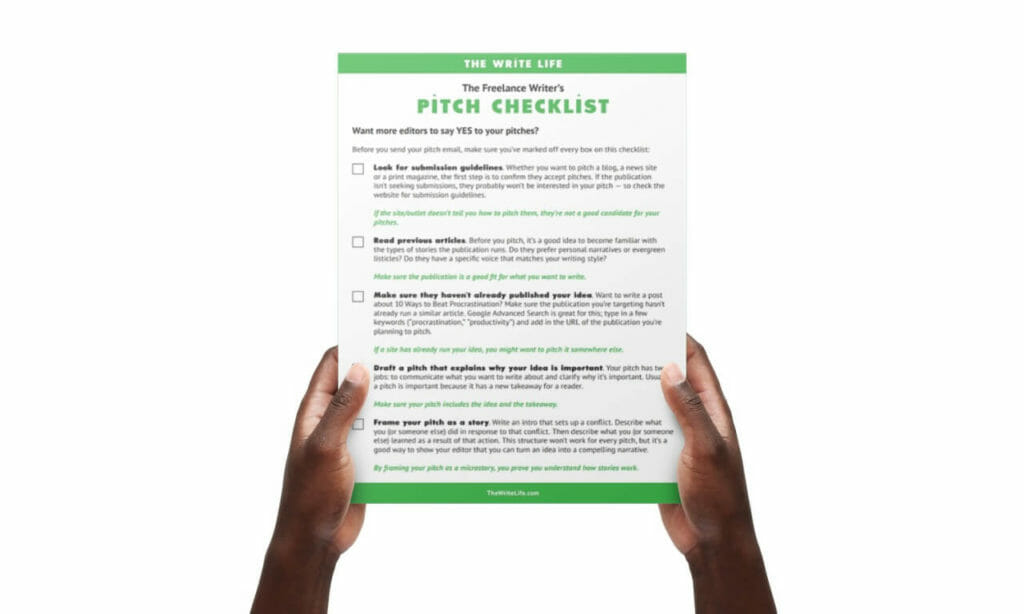The Write Life wants to help you get better at pitching! Grab our freelance writer’s pitch checklist.
As an editor, I read a lot of pitches.
Some of them are really easy to say yes to — they’re the pitches that outline a strong, clear narrative with a takeaway for the reader. Other pitches are easy to say no to — they’re either poorly written, irrelevant to the publication or (as is often the case), both.
It’s the ones in between that are hard.
Every day I see writers pitch ideas or topics that could be great stories if they’d done a little more work or written a slightly better pitch. Sometimes I ask them to rework their pitch.
Sometimes I take a chance and hope there’s a good story in there. But often, I say no. After all, I have plenty of better pitches in my inbox.
Pitch mistakes even good writers tend to make
If you’re a writer who’s sending out pitches but not getting a lot of assignments, maybe you’re writing those in-between types of pitches, the kind that could be really good with a little improvement.
Here are three of the most common pitch mistakes I see every day, along with how to fix them.
1. Do your “exploring” before you pitch
If there’s one word I hate to see in a pitch, it’s “explore.”
A writer who wants to explore an idea is a writer who doesn’t know what they want to write yet.
These are the kinds of pitches that sit in my inbox for days because the writer usually wants to explore something interesting — but I don’t know if that exploration will result in a good story.
I understand you don’t want to do a lot of work before pitching an article that might never get picked up. But instead of writing this:
Now that the Ringling Bros. and Barnum & Bailey circuses have officially closed, I’d like to explore what happens to the animals after the circus shuts down.
Try this:
What does retirement look like for a circus elephant? Can an unemployed hoop-jumping dog get a job in Hollywood? The Ringling Bros. and Barnum & Bailey circuses ended their 146-year run this summer, and this piece will look at what the future might hold for the big top’s animal employees.
In both cases, the writer hasn’t yet done the research required to answer the question. But the second pitch proves that the writer has thought about a few possibilities and has moved past the exploration stage.
If you’d like to learn more about how to pitch a piece that requires research, including when and how to list sources, check out our Pitch Checklist.
2. If you’re pitching a personal narrative, put the narrative into the pitch
When I see a pitch like this:
I’d like to pitch a story about the summer I interned at the circus.
My immediate response is: okay, pitch me that story.
If you’re pitching a personal narrative, make sure your pitch includes the narrative. The beginning, the middle and the end.
Ever since I was a kid, it was my dream to run away and join the circus. So, when I was in college, I did the next best thing: I signed up for an internship. I knew that circuses took a lot of work, but I didn’t realize that I’d be balancing three rings of retail, company management and customer service all at once. And, like the elephants, I was getting paid peanuts.
Did I learn a lot that summer? Yes — including the fact that the circus life was not for me. But I still use the skills I learned while ringing up T-shirts and cleaning up empty cotton candy bags, and I’ll never forget the nights I spent under the big top.
Notice that this second pitch also uses the type of language I’d expect to see in a finished piece. Metaphor, imagery, even a bit of humor. Don’t be afraid to let your writing style show — after all, editors are evaluating both what you pitch and how you pitch it.
For more tips on pitching a personal narrative, read check out our Pitch Checklist.
3. Don’t stop your pitch where your story begins
Here’s one more common pitch mistake that I see almost every day.
Writers send in detailed, well-written pitches that end right before the story begins:
When I was six, the circus came to town. I spent the next week playing circus with my stuffed animals and trying to get my dog to jump through my hula hoop. Some kids would move on to another interest, but not me — I remained circus-obsessed for my entire childhood. By the time I was a teenager I could name the ringmasters of all the major circuses, and knew the history and symbolism of the different types of clown makeup.
When I went to college, I knew I wanted to run my own circus someday. So, during my junior year, I got an internship with a local circus. That’s when I learned that although the circus had made everything seem effortless, running a circus took a lot of work.
I’d like to write a 1,500 word essay about my internship and what I learned. I’ve previously been published at […]

The personal narrative example, above, is a better way to pitch this piece. You could even frame the central conflict at the beginning of your pitch: “What happens when you achieve your childhood dream — and discover that you no longer want it?” That lets an editor know exactly what your story is going to be about, and whether it’s going to be a good fit for the publication.
Here are a few more good pitching resources:
How to Sell a Story That Relies on a News Peg
Take This Scientific Approach For Your Next Freelance Writing Pitch
Pitching Long-Form Journalism? Don’t Forget Your Goal
The more you know about what editors are looking for when they go through the pitch inbox, the more likely your pitch will go from “maybe” to “yes” — and that’s good for both you and your editor, because you’ll get a new gig and your editor will get a great story.
Writers: are you making any of these common pitch mistakes? Editors: any other pitching advice to share?








